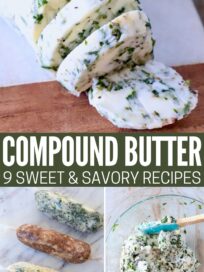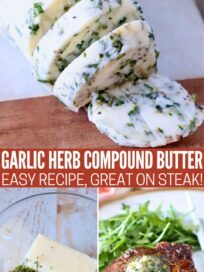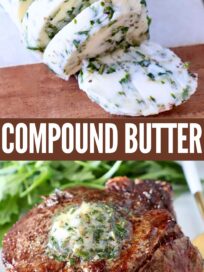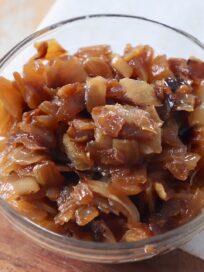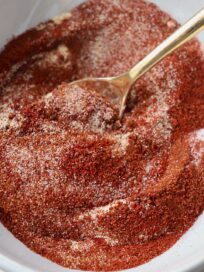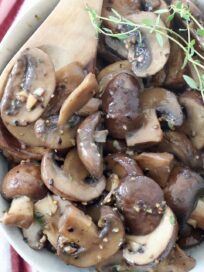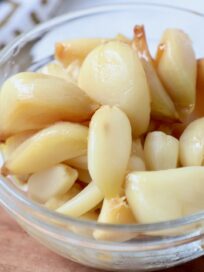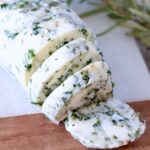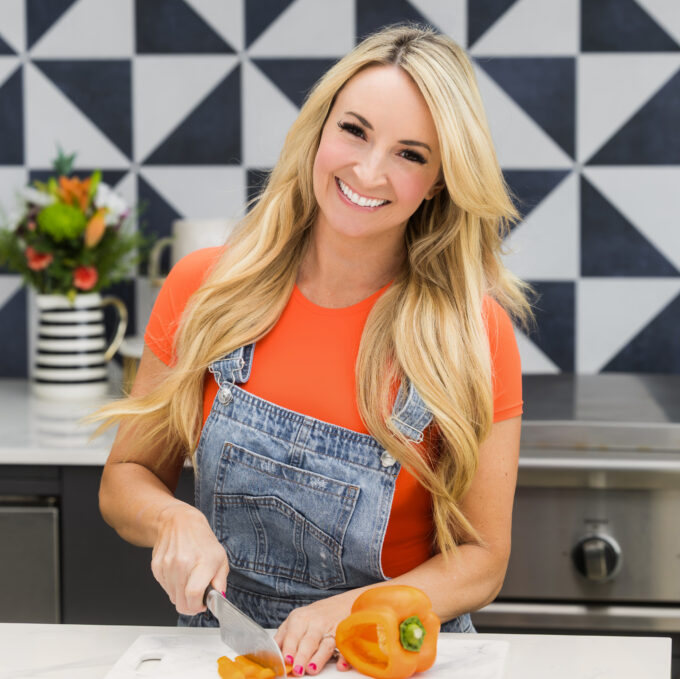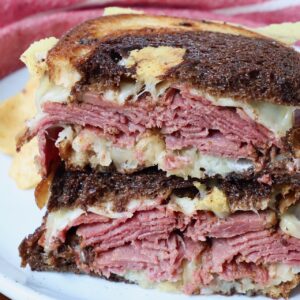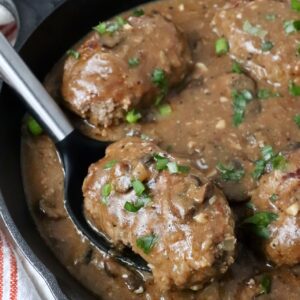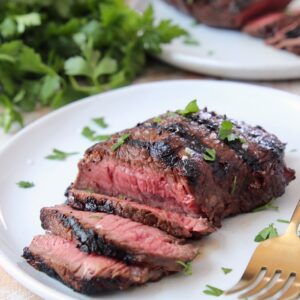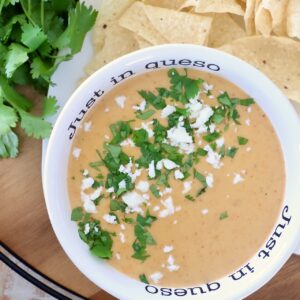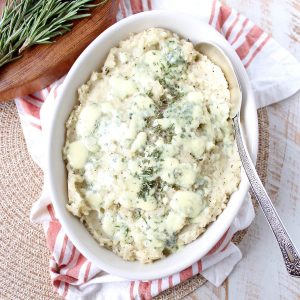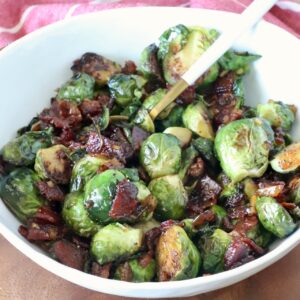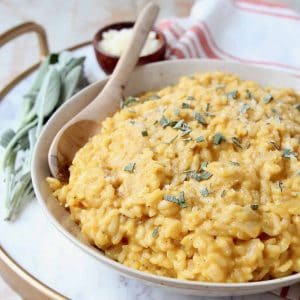Compound Butter
This post may contain affiliate links.
Add so much flavor to your meals by learning how to make homemade Compound Butter with this easy recipe! You can make garlic herb compound butter, also known as steak butter, and add it on top of steaks, in baked potatoes, or use it when roasting a turkey or chicken. You can also make sweet compound butter, which is delicious spread on biscuits, bread, or waffles!
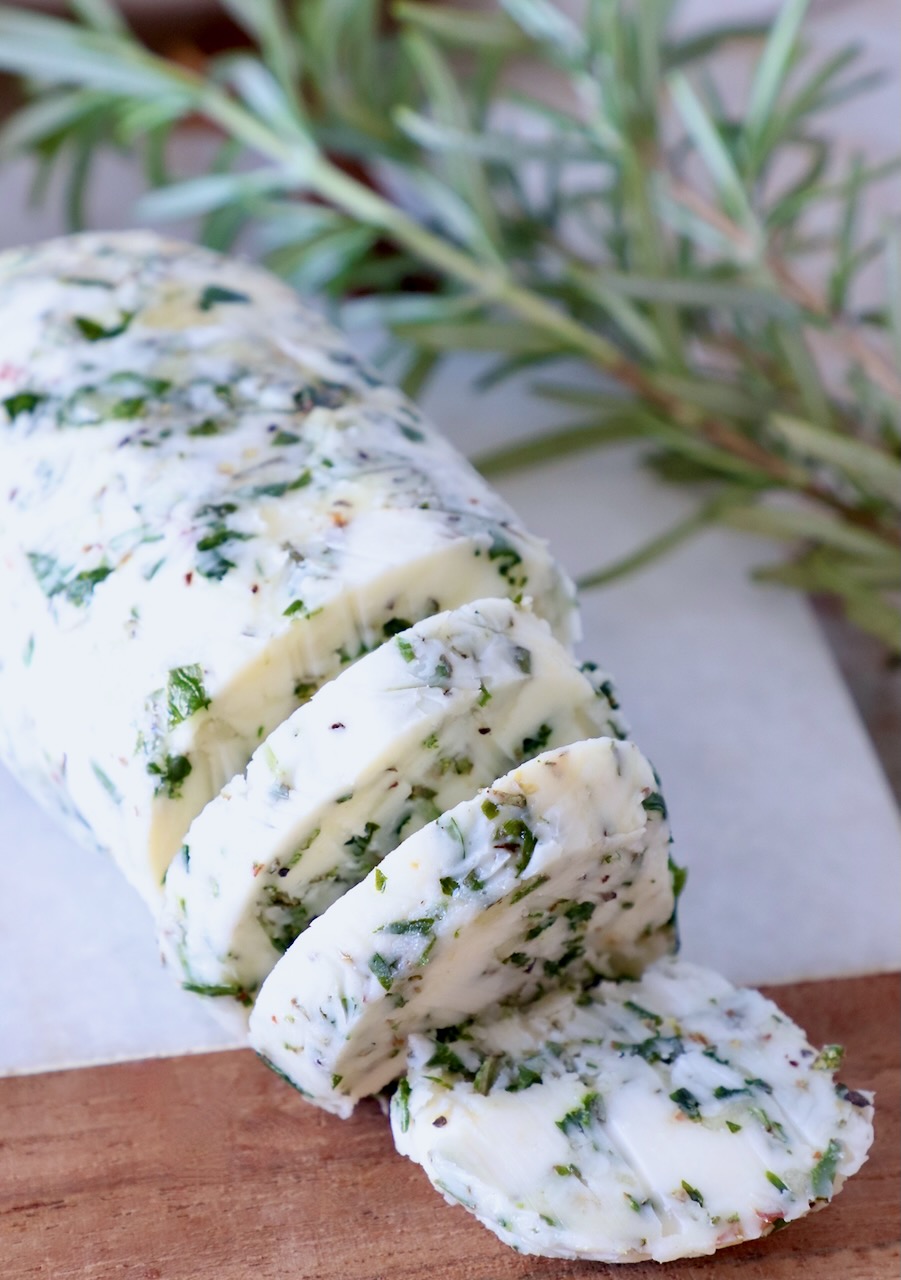
Why you’ll love compound butter
A few years back, I had the honor of working with a former culinary instructor on her line of chefs aprons. She taught me some of her insider secrets from working in restaurant kitchens for many years. And one of her secrets was compound butter.
I had made compound butter before, but it wasn’t something that I regularly used in my kitchen or on the blog. After she and I made a variety of compound butters for a video series, I was hooked on making compound butter and putting it on everything!
Here’s why you’ll love compound butter and always keep it in your fridge from now on!
- It adds bold flavors to any meal. You can keep it as simple as spreading it on a piece of toast. Or impress friends and family by finishing a prime rib with compound butter. Anything you add the butter to magically transforms into something delicious!
- You can mix it up to suit your tastes. Compound butter takes on any flavor you add to it, so if you love garlic, load it up with fresh crushed garlic. If you’re a fan of cinnamon, load it up with maple syrup and ground cinnamon. Whether you’re adding sweet or savory flavors to the butter, I always recommend adding salt to enhance the flavors.
- It’s easy to make! Once the butter is softened, it only takes 5 minutes to mix up compound butter. Pop it back in the fridge and after an hour, add it to any dish you’d like!
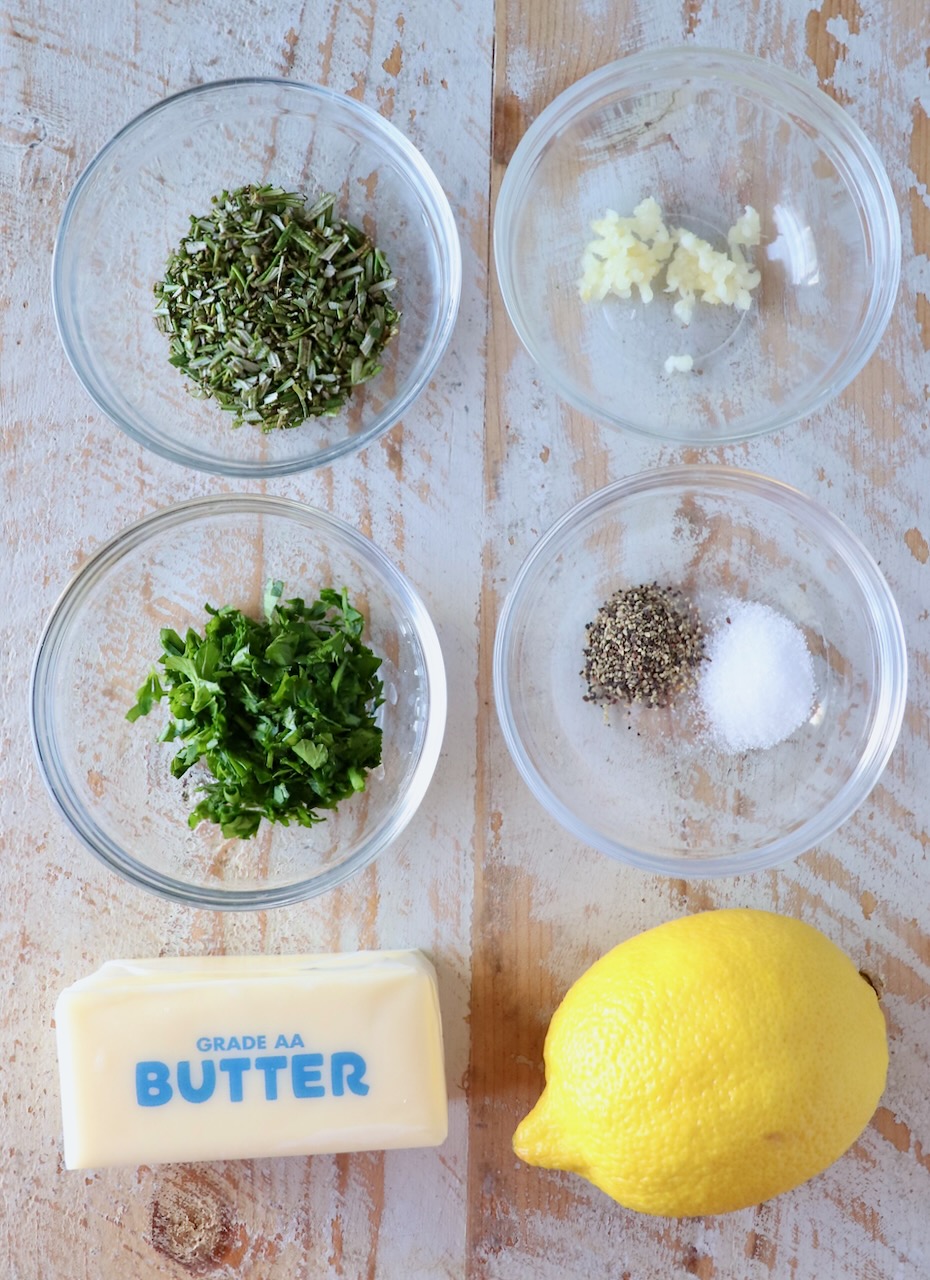
Ingredients
Here I explain the best ingredients for a classic herb compound butter recipe. For the exact ingredient measurements, see the recipe card at the bottom of this post. For a full list of compound butter recipes, click the link to check out the section below.
- Unsalted butter – this will be the base for any compound butter. I always recommend starting with unsalted butter, that way you can control the amount of salt added to the butter, and salt to your taste.
- Salt – speaking of salt, I do recommend adding salt to compound butter. No matter whether it’s sweet or savory, the salt will help bring out the flavors in the butter.
- Garlic – I love the combination of garlic and fresh herbs, so for this herbed butter recipe, I recommend crushing (or grating) 2 medium-size cloves of garlic into the butter. If the cloves are really large, only use one clove. I find that crushing the cloves of garlic in a garlic press is easier than grating the garlic with a microplane, but either one will work. You just want to make sure that the garlic is fine enough that you don’t have large chunks in the butter. If you want to add even more bold flavors to your compound butter, you can add roasted garlic.
- Herbs – here’s where you can have a little fun and mix things up if you like! I always recommend using 2 tablespoons of chopped fresh herbs, but you can mix and match which herbs. I usually like to use a combination of a woodsy herb, like rosemary or thyme, with a more delicate herb, like parsley, basil or dill. But most of the time it just comes down to what’s in my fridge. Even if you only have one herb, you can double-down on that herb in the butter.
- Black pepper – just a quarter of a teaspoon will add a light, peppery flavor to the butter.
- Lemon juice (optional) – I enjoy the acidity and bright flavor of lemon in this herbed compound butter recipe, but it is optional and the butter will still be delicious without it.
Instructions
I’ve included step by step photos below to make this recipe easy to follow at home. For the full detailed recipe instructions, scroll to the recipe card at the bottom of this post.
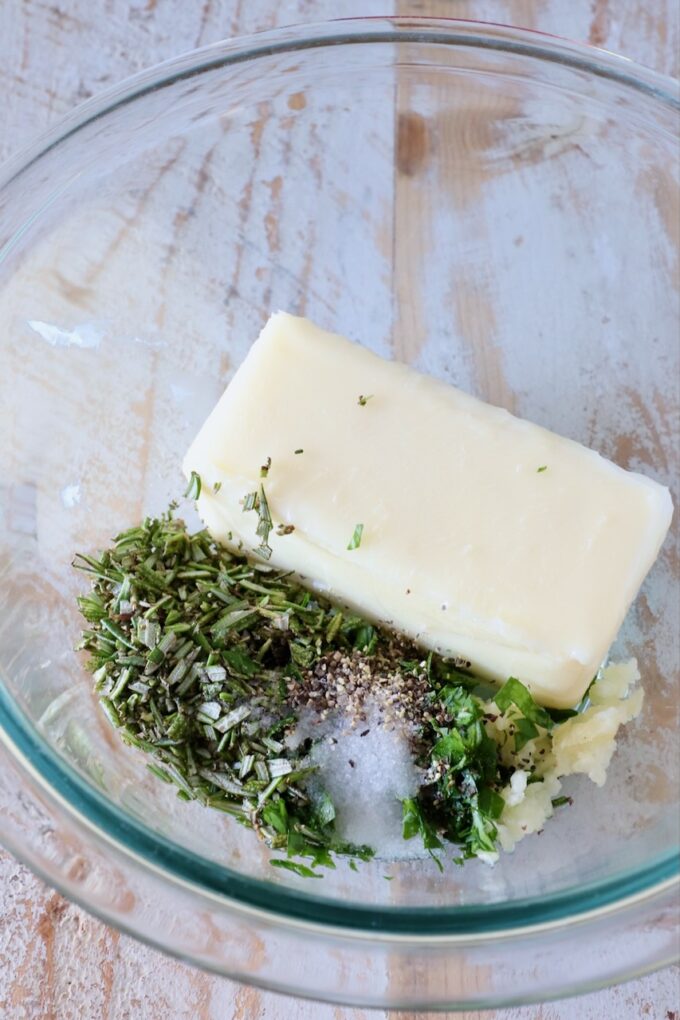
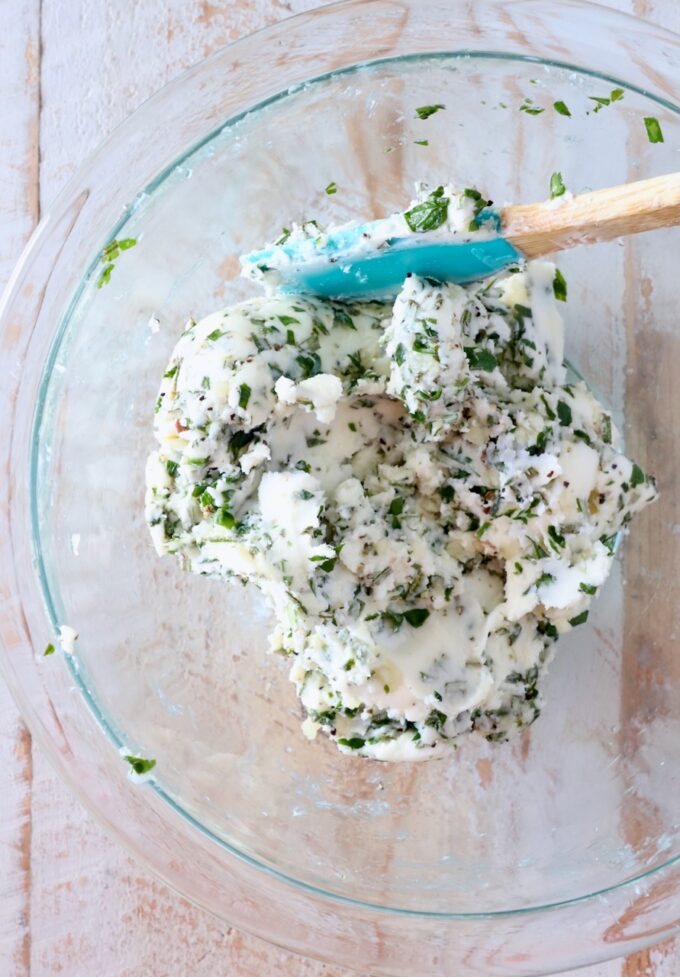
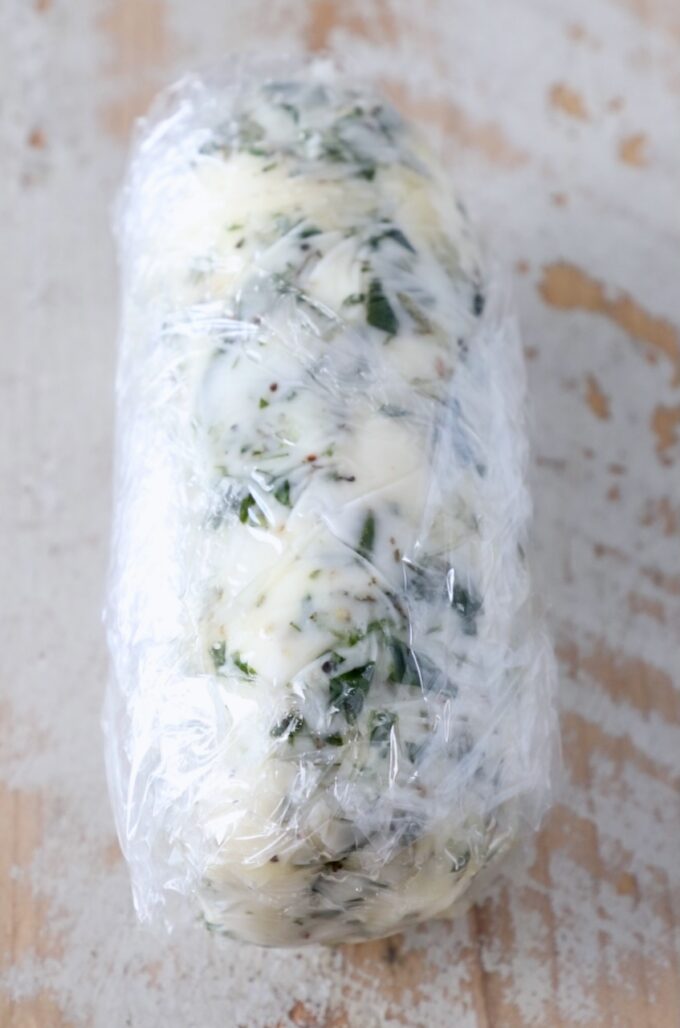
- Bring the butter up to room temperature. The best way to do this is by letting the butter sit on the counter at room temperature for 60-90 minutes. I do not recommend trying to soften the butter quicker in the microwave. This will likely melt the outside edges of the butter, but the inside of the butter will still be too hard. Just pop it from the fridge to the counter and go about your day, then come back in an hour and mix up the compound butter.
- Mix in the compound butter additions of your choice. For this recipe, we’re adding chopped parsley, chopped rosemary, crushed garlic, lemon juice, salt and pepper. Use a spatula to fold all of the ingredients evenly into the softened butter in a bowl. I do not recommend using your hands to do this. The heat from your hands can make the butter too soft.
- Wrap up the butter. Lay out a sheet of plastic wrap, then place the butter mixture in the middle. Roll the plastic wrap up and over the butter, forming it into a small round log. You want it to be even from end-to-end. This way, when you slice the butter, each slice will be the same size.
- Refrigerate the butter. Once it’s wrapped up, place the butter back in the fridge for at least one hour. This will allow the butter to firm up and the flavors to meld together.
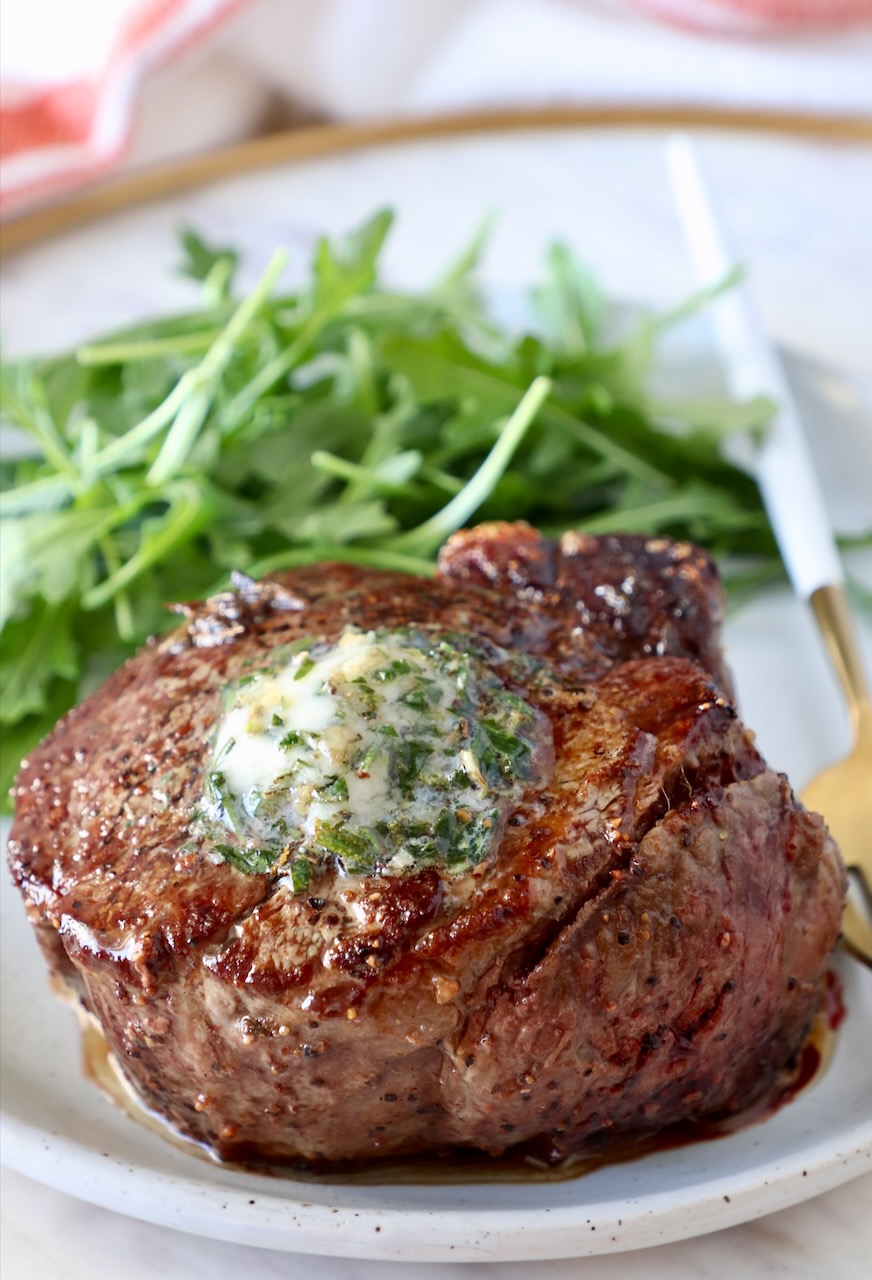
Ways to use it
This herb garlic compound butter can be used in a variety of different ways. And you can mix up which herbs you use, depending on the ways you plan to use it.
Basil, thyme, rosemary, parsley, sage, dill, or chives, are all flavorful fresh herbs that can be added to this herb butter recipe. Here are some of my favorite ways to use it and which herbs I recommend based on the use of the butter.
- Steak – this is my favorite way to use herb butter. Simply place a slice of the compound butter on top of the steak as soon as you finish cooking it. While the steak rests, the butter will gently melt over the steak, adding so much flavor. As seen above, melting over a grilled filet mignon. You can also try it with sirloin steak, sous vide steak, air fryer steak, skirt steak, or your favorite cut of steak. For steaks, I really like the combination of parsley and rosemary.
- Turkey – add slices of the compound butter under the skin of a turkey before smoking the turkey or roasting it. The butter will slowly melt under the skin and make the turkey moist, tender and juicy. For turkey, I like to use a combination parsley, sage, rosemary and thyme. When using four herbs, you’ll only need 1/2 tablespoon of each in the butter.
- Chicken – after cooking anything from a whole chicken, to chicken thighs, to chicken breasts, you can top it with compound butter and let it melt over the chicken to keep it moist and juicy. I like to use a combination of rosemary and basil to pair with chicken.
- Prime rib – my roasted bone-in prime rib recipe is incredibly popular during the holiday season. And while it’s already covered in an herb butter rub before it’s roasted, you could certainly finish the dish by letting a few slices of compound butter melt over the prime rib, for even more buttery garlic flavor. For this, I like to use a combination of 1 tablespoon rosemary, 1/2 tablespoon thyme and 1/2 tablespoon parsley.
- Seafood – herb butter is delicious on fish like salmon, sea bass or tilapia. It’s also delicious with shellfish. I like to use more delicate herbs for this and recommend a combination of basil and chives.
- Vegetables – top vegetables with compound butter before roasting them in the oven. This is perfect for vegetables like broccoli or cauliflower. Or finish vegetables fresh off the grill with compound butter. This is great for asparagus or corn on the cob. You can also add the butter to a warm baked potato or mix it into mashed potatoes for the most flavorful potatoes ever!
- Bread – making garlic bread with garlic herb compound butter is so easy and flavorful. To keep things simple, just spread the butter over toasted slices of bread. If you want to make a whole loaf of bread, slice a loaf of french bread in half lengthwise through the middle. Spread softened compound butter on the sliced side of each piece of bread. Place on a baking sheet, with the butter side facing up, and into a 425°F preheated oven for 10-15 minutes. Remove from the oven and slice into 1 inch pieces for serving. For a whole loaf of bread, you’ll want to use the entire 1/2 cup of prepared compound butter. This recipe is also great on dinner rolls!
- Pasta – mix garlic herb butter with cooked pasta noodles and parmesan cheese to make a simple pasta dish for dinner. For this, I like to use a combination of Italian herbs including Italian parsley and basil.
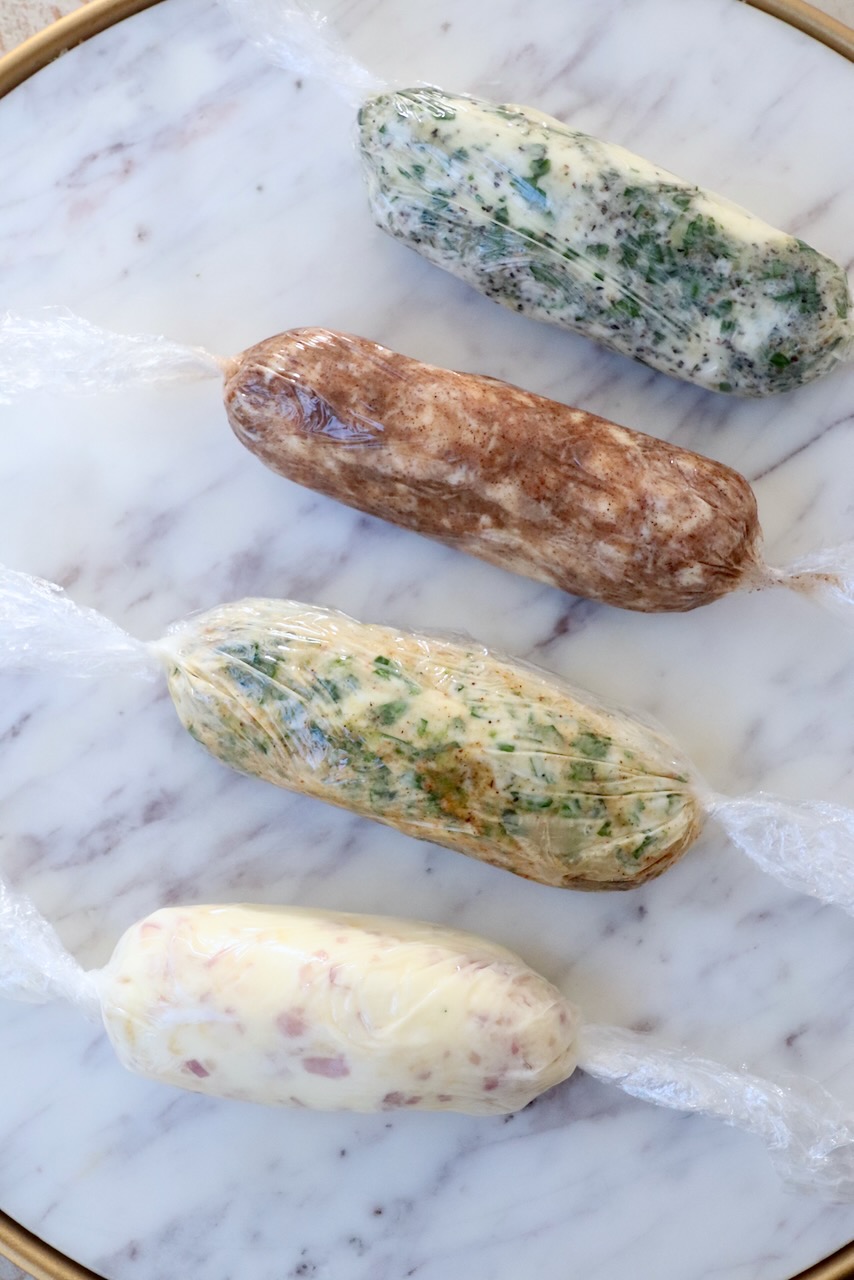
More compound butter recipes
The basic “recipe” for compound butter is 1 stick butter (1/2 cup) with 1/2 teaspoon salt and at least 2 tablespoons of additional ingredients. These additional ingredients can change and vary based on your personal tastes and how you want to use the compound butter.
Here are a list of compound butter recipes that I’ve tried over the years, and the best uses for each one.
- Rosemary lemon – 1/2 cup butter + 1/2 teaspoon salt + 2 tablespoons chopped fresh rosemary + 1/2 teaspoon lemon juice + 1/2 teaspoon lemon zest + 2 cloves crushed garlic. This combination is delicious on top of grilled chicken! Try it on this lemon rosemary chicken. It’s also great on seafood, especially this lemon herb salmon.
- Garlic shallot – 1/2 cup butter + 1/2 teaspoon salt + 2 tablespoons minced shallots + 2 crushed garlic cloves. This butter is delicious on top of steaks, or melted over cooked shellfish, like mussels, clams, lobster, or crab.
- Maple cinnamon – 1/2 cup butter + 1/2 teaspoon salt + 1 tablespoon maple syrup + 1 teaspoon ground cinnamon. This is the perfect recipe for sweet compound butter that’s delicious spread on biscuits, cornbread, french toast, waffles, or pancakes. It’s also great on baked sweet potatoes!
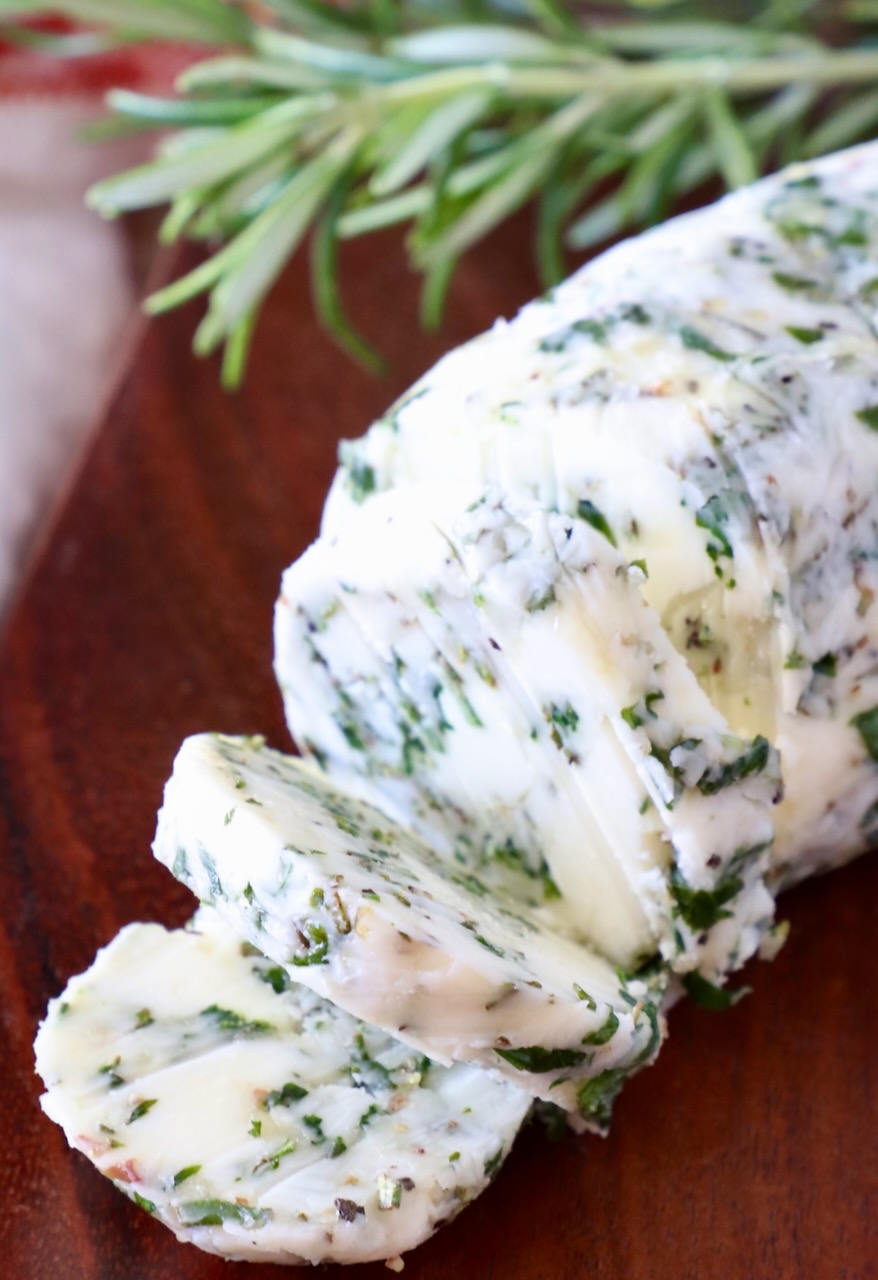
More flavor enhancers
Follow these blog posts to make flavorful additions to your meals. Just like adding compound butter adds flavor to steaks, adding caramelized onions adds flavor to burgers, and a secret homemade seasoning blend adds flavor to wings!
Compound Butter
Ingredients
- ½ cup unsalted butter
- 2 tablespoons fresh herbs, basil, thyme, rosemary, parsley, sage, dill or chives
- 2 cloves garlic, crushed
- ½ teaspoon kosher salt
- ¼ teaspoon black pepper
- ½ teaspoon fresh lemon juice, optional
Instructions
- Soften butter to room temperature. This will take 60-90 minutes of the butter sitting at room temperature on the counter. Add other ingredients and mix until thoroughly combined.
- Add the softened butter to a bowl with the chopped fresh herbs, crushed garlic, salt and pepper. Optionally add the lemon juice.
- Place the butter in the middle of a piece of plastic wrap. Wrap the butter up tightly and twist the ends to seal.
- Place in the refrigerator for at least one hour so that it will firm up and the flavors will meld together.
- Use the butter immediately, or store it in the refrigerator for up to 2 weeks. It can also be stored in the freezer for up to 3 months.
Notes
- Fresh herbs: I always recommend using 2 tablespoons of chopped fresh herbs, but you can mix and match which herbs. I usually like to use a combination of a woodsy herb, like rosemary or thyme, with a more delicate herb, like parsley, basil or dill. Even if you only have one herb, you can double-down on that herb in the butter. The butter pictured in this post was made with 1 tablespoon rosemary and 1 tablespoon parsley.
- The lemon juice is optional. It will add a bright citrus flavor to the butter, but isn’t necessary for the success of the recipe.
- For more compound butter recipes, including a sweet compound butter, refer to the blog post above.
- For ways to use the compound butter, refer to the blog post above.
Nutrition Facts
We are a participant in the Amazon Services LLC Associates Program, an affiliate advertising program designed to provide a means for sites to earn advertising fees by advertising and linking to amazon.com.


